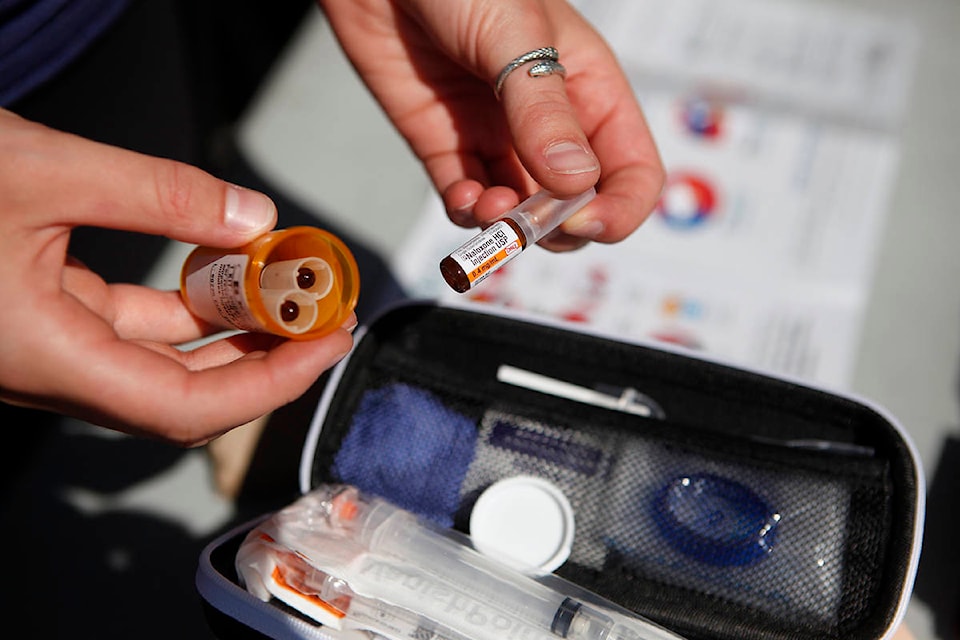The province recorded 175 fatal overdoses in July, pushing the total deaths from illicit drugs in B.C. to above 900 this year.
July marked the third month in a row where overdose deaths topped 170 and was down just two from a record-breaking month in May, when 177 people died. The province reached a grim milestone of 909 deaths so far in 2020 due to illicit drug overdoses, compared to 618 in the first seven months of 2019.
“The toxicity of drug supply is extreme,” provincial health officer Dr. Bonnie Henry said. Henry and Premier John Horgan have pushed to decriminalize simple possession of prohibited drugs.
READ MORE: B.C. premier asks Trudeau to decriminalize illicit drug possession as deaths climb
According to the B.C. Coroners Service, 5.6 British Columbians died each day due to illicit drug overdoses. In July 2019, 74 people died.
Chief Coroner Lisa Lapointe called the deaths “profound and tragic.” Drug overdoses have killed nearly 6,000 people in B.C. The number of people dying of overdoses in the province continues to surpass deaths due to homicides, motor vehicle incidents, suicides and COVID-19 combined, she added.
“We continue to see an increase in death due to extreme fentanyl concentration,” Lapointe said. Fentanyl has been present in 78 per cent of deaths so far in 2020.
“If you are using illicit substances… it is critical you use only in the presence of someone willing and able to inject naloxone.”
Lapointe said that although the overdose crisis can often seem to be a problem of the Downtown Eastside, “every demographic in this province” has been hit by the crisis.
Broken down by health authority, 285 people died in Fraser Health, 254 people in Vancouver Coastal Health, 165 in Island Health, 143 in Interior Health and 62 in Northern Health. However, Northern Health has the highest rate of death at 35.4, with Vancouver Coastal Health at 35.1, Island Health at 33.2, Interior Health at 30.6 and Fraser Health at 25.5.
Henry’s voice broke as she offered condolences to the families and friends of victims of the overdose crisis.
“I implore anybody who is using drugs right now, do not do it alone. You need to have your lifeguard there,” she said.
Henry acknowledged that the measures taken in the fight against the COVID-19 pandemic have made drug toxicity worse in B.C. Some supervised consumption sites have shortened their hours due to physical distancing concerns, and overall isolation has increased due to the pandemic.
“The pandemic has uncovered some of the inequities that we have in our society,” she said.
Guy Felicella, peer clinical advisor with the Overdose Emergency Response Centre and BC Centre on Substance Use, had harsh words for the provincial and federal governments.
“W have to save people’s lives and we’re failing miserably in doing that,” Felicella said. “This crisis has been decades in the making.”
Felicella, who has struggled with substance use in the past, said the pandemic response has shown where government priorities lie.
“More people die of a drug overdose than die of COVID,” he said. The virus has killed 203 people so far in B.C, compared to the 909 overdose deaths.
READ MORE: Parallel crises: How COVID-19 has exacerbated the drug overdose emergency
But with the increasing drug toxicity of the supply in B.C., health official said that naloxone is not enough. Paramedics responded to about 2,700 overdose calls in July, more than any other month since the crisis began in 2016.
Jon Deakin, paramedic practice leader with BC Emergency Health Services, said that while naloxone is the first step, bystanders should call 911 right away.
Deakin said 95 per cent of people survive an overdose when treated quickly by a paramedic.
Lapointe said the “shame and stigma” of illicit drug use causes many people to use alone and not head to the province’s supervised consumption sites. No deaths have been reported at those sites.
“There are so many repercussions currently if people become aware that you are experiencing problematic substance use,” she said, adding that the sites should be no more controversial than going to a walk-in doctors clinic.
“Obviously, punishment is not something that is helpful. Shaming people is not something that is helpful.”
The majority of drug overdose deaths happen when people use alone; in July, 85 per cent of fatal incidents took place inside. Of those, 56 per cent were in private residences and 29 per cent were in social and supportive housing, SROs (single room occupancy), shelters, hotels and other indoor locations. The 14 per cent that occured outside happened in vehicles, on streets and in parks.
As has been the case throughout the overdose crisis, the majority of overdose deaths are men under the age of 50. In 2020 so far, 79 per cent of deaths have been men and 68 per cent have been men between the ages of 19 and 49.
READ MORE: Nearly 6 people died from overdoses each day in June as B.C. sees continued spike
Like us on Facebook and follow us on Twitter.
Want to support local journalism during the pandemic? Make a donation here.
